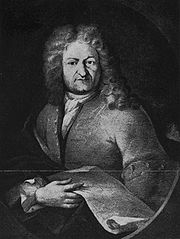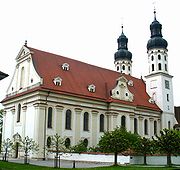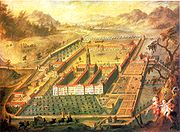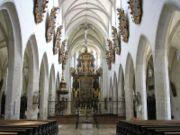
Franz Beer
Encyclopedia




Architect
An architect is a person trained in the planning, design and oversight of the construction of buildings. To practice architecture means to offer or render services in connection with the design and construction of a building, or group of buildings and the space within the site surrounding the...
during the Baroque
Baroque
The Baroque is a period and the style that used exaggerated motion and clear, easily interpreted detail to produce drama, tension, exuberance, and grandeur in sculpture, painting, literature, dance, and music...
period, mainly working on church buildings at monasteries
Monastery
Monastery denotes the building, or complex of buildings, that houses a room reserved for prayer as well as the domestic quarters and workplace of monastics, whether monks or nuns, and whether living in community or alone .Monasteries may vary greatly in size – a small dwelling accommodating only...
in southern Germany
Germany
Germany , officially the Federal Republic of Germany , is a federal parliamentary republic in Europe. The country consists of 16 states while the capital and largest city is Berlin. Germany covers an area of 357,021 km2 and has a largely temperate seasonal climate...
, chiefly in Upper Swabia
Upper Swabia
Upper Swabia is a region in Germany in the federal states of Baden-Württemberg and Bavaria. The name refers to the area between the Swabian Alb, Lake Constance and the Lech...
, and Switzerland
Switzerland
Switzerland name of one of the Swiss cantons. ; ; ; or ), in its full name the Swiss Confederation , is a federal republic consisting of 26 cantons, with Bern as the seat of the federal authorities. The country is situated in Western Europe,Or Central Europe depending on the definition....
. His son Johann Michael Beer also was an architect.
Born in Au im Bregenzerwald in Vorarlberg
Vorarlberg
Vorarlberg is the westernmost federal-state of Austria. Although it is the second smallest in terms of area and population , it borders three countries: Germany , Switzerland and Liechtenstein...
, Beer was apprenticed to Michael Thumb. His first major project was the monastery church at Marchtal Abbey
Marchtal Abbey
Marchtal Abbey is a former Premonstratensian monastery in Obermarchtal in the Alb-Donau-Kreis, Baden-Württemberg, Germany. The minster church of Saints Peter and Paul, the former abbey church, located on a prominent elevation, still dominates the landscape for miles around.-First foundation:In 776...
near Obermarchtal
Obermarchtal
Obermarchtal is a town in the district of Alb-Donau in Baden-Württemberg in Germany....
which he completed after the death of Thumb in 1690, together with the latter's son, Christian Thumb, also an architect. He also had the churches at Rheinau Abbey
Rheinau Abbey
Rheinau Abbey was a Benedictine monastery in Rheinau in the Canton of Zürich, Switzerland, founded in about 778 and suppressed in 1862.-History:...
and the monastery of Saint Urban, both in Switzerland, built. Amongst other projects, he was involved in the construction of the churches at Weingarten Abbey
Weingarten Abbey
Weingarten Abbey or St. Martin's Abbey is a Benedictine monastery on the Martinsberg in Weingarten near Ravensburg in Baden-Württemberg .-First foundation:...
, which started in 1717, and Weissenau Abbey
Weissenau Abbey
- References : Binder, Helmut , 1995. 850 Jahre Prämonstratenserabtei Weissenau. 1145–1995. Sigmaringen: Thorbecke. ISBN 3-7995-0414-1 Eitel, Peter , 1983. Weissenau in Geschichte und Gegenwart. Festschrift zur 700-Jahrfeier der Übergabe der Heiligblutreliquie durch Rudolf von Habsburg an die...
from 1717 until 1724.
Together with Michael Thumb, Christian Thumb and Kaspar Moosbrugger, he was one of the main representatives of the so-called Voralberg school of architecture, which continued the Roman Baroque ideal of long edifices with galleries and mainly two bell towers.
In 1722, he was ennobled and took the name Franz Beer, Edler von Blaichten.
He died in the Austrian town of Bezau
Bezau
Bezau is a town in the Bregenzerwald, Vorarlberg, Austria, part of the district Bregenz. As of 2002 it has a population of 1,926. Bezau is a popular tourist destination around the year, due to its vicinity to ski resorts and hiking trails. Its pittoresque church was built in 1906 and is devoted to...
.
Works
- Marchtal Abbey, abbey church.
- Rheinau Abbey, abbey church.
- Saint Urban, abbey church.
- Weingarten Abbey, abbey church.
- Salem AbbeySalem AbbeySalem Abbey , also known as Salmansweiler and in Latin as Salomonis Villa, was a very prominent Cistercian monastery in Salem in the district of Bodensee about ten miles from Konstanz, Baden-Württemberg, Germany.-Abbey:The abbey was founded in 1136 by Gunthram of Adelsreute Salem Abbey (Kloster or...
, reconstruction of the monastery 1697-1710, including a chapel in nearby Stefansfeld. - Hauterive Abbey, from 1715
- Kaisheim AbbeyKaisheim AbbeyKaisheim Abbey was a Cistercian monastery in Kaisheim, Bavaria, Germany.- History :It was founded by Henry II, Count of Lechsgemünd and his wife Liutgard, and was a daughter house of Lucelle Abbey in Alsace. Count Henry's initial gift of the land was made in 1133; the foundation charter was dated...
, from 1716 - Gengenbach AbbeyGengenbach AbbeyGengenbach Abbey was a Benedictine monastery in Gengenbach in the district of Ortenau, Baden-Württemberg, Germany.-History:It was founded by Saint Pirmin sometime after his expulsion from Reichenau in 727 and settled by monks from Gorze Abbey. It enjoyed good relations with the Carolingian...
, reconstruction of the monastery and bell towerBell towerA bell tower is a tower which contains one or more bells, or which is designed to hold bells, even if it has none. In the European tradition, such a tower most commonly serves as part of a church and contains church bells. When attached to a city hall or other civic building, especially in...
1690-1722.

